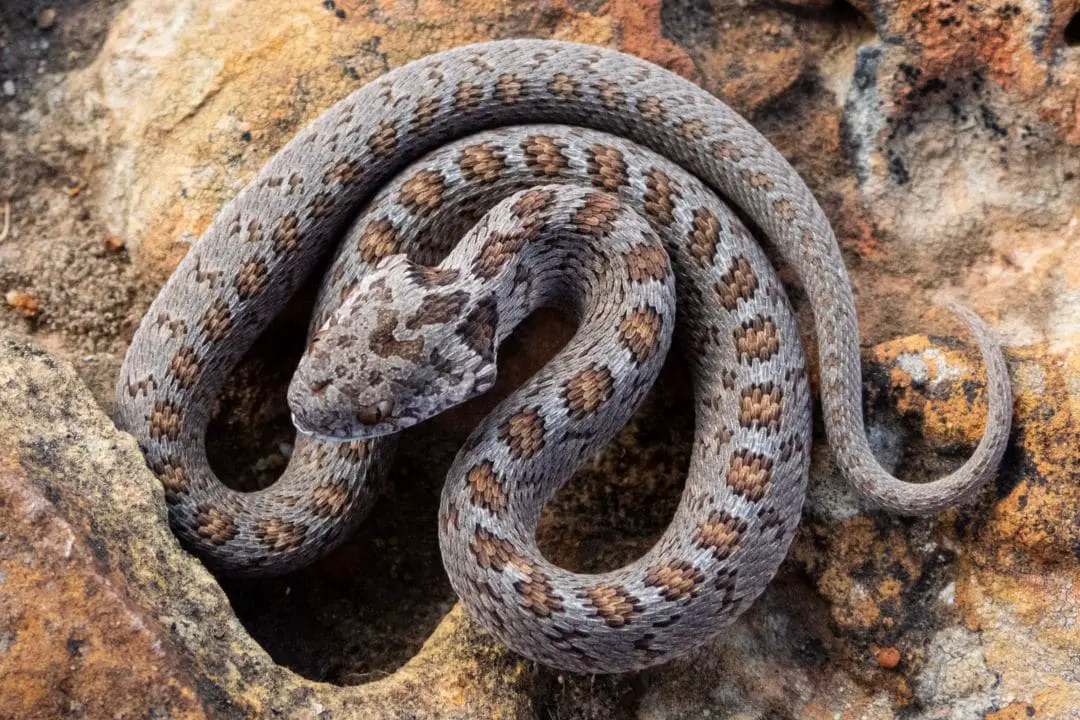Egg eating snakes belong to the genius Dasypeltis and are members of the Colubridae family.
There are 17 species in this genius, with the African egg-eating snake (Dasypeltis scabra) being the most well-known.
It is also known as the common egg-eating snake or the rhombic egg-eating snake. If you find an egg-eating snake for sale, the odds are that it will be the African egg-eating snake, as the other species are rarely, if ever, available.
Egg-eating snakes can be found in the Middle East and sub-Saharan Africa. Dasypeltis scabra has the widest distribution of any other members of the genius.
In their natural habitat, egg-eating snakes live on the edges of savannas and forests, where birds most commonly nest.
A small species, the African egg-eating snake averages between 24-30 inches in length. It has grayish-brown colored scales with black or dark brown spots or bands. They have a white belly and a small roundish head.
As pets, this snake is one of the easiest snake species to keep if you can overcome the challenge of feeding them! As its name indicates, the only thing the African egg-eating snake eats is eggs!
Given their specialized diet, these snakes are mostly sought after by reptile keepers looking for something different for their collection. This care guide provides an overview of how to keep this species successfully.
- Housing
- Feeding
- Shedding
- Hibernation
- Handling
- Breeding
- Common Health Issues
- Frequently Asked Questions
- Is the African egg-eating snake a good pet?
- Do African egg-eating snakes bite?
- Are African egg-eating snakes friendly?
- Which types of snakes eat eggs?
- How much do African egg-eating snakes cost?
- What is the biggest egg-eating snake?
- Are there members of the Dasypetis family that are venomous?
- Are there any African egg-eating snake morphs?
- Can African egg-eating snakes be housed together?
- Do African egg-eating snakes eat fertile eggs?
- Can African egg-eating snakes eat chicken eggs?
- Conclusion
- Sources
Housing
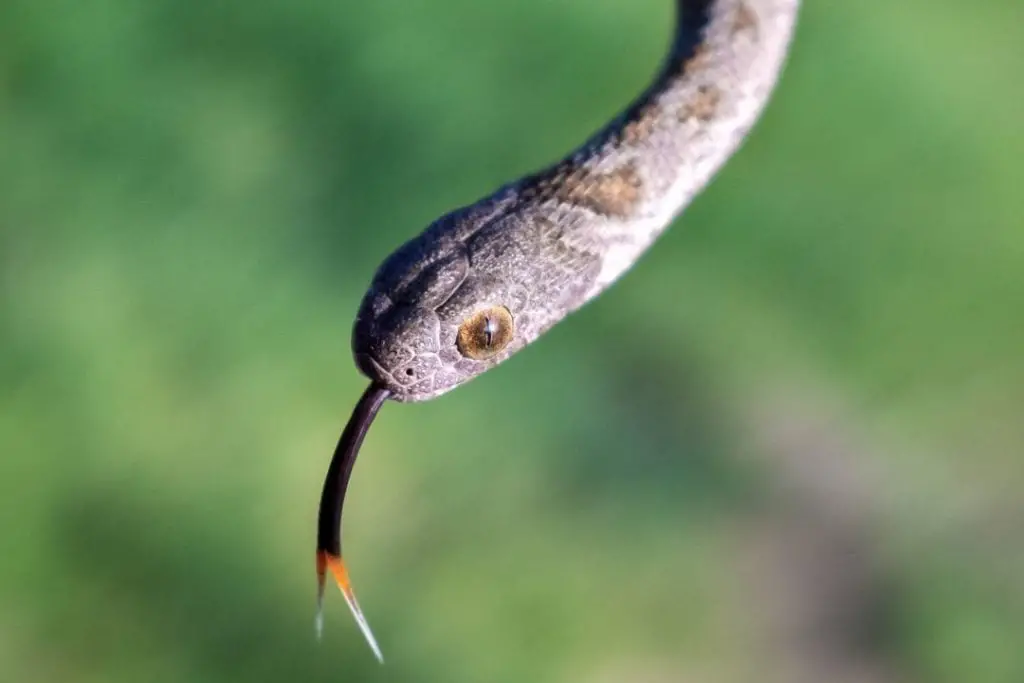
African Egg-Eating Snake Enclosure
African egg-eating snakes are a small species, with the average size of adults between 24 and 30 inches. For this reason, they do not require a large enclosure.
Though this species is known for climbing trees, the length of the enclosure is more important as they are largely terrestrial.
Size for African Egg-Eating Snakes
The African egg-eating snake reserves its climbing efforts mostly for when it is looking for bird eggs. For this reason, the floor space should take priority over climbing space.
A standard 20-gallon aquarium for vivarium is adequate. If you are building the housing yourself, an enclosure measuring at least 24 inches wide, 18 inches deep, and 12 inches high will meet your snake’s needs.
Ready-made reptile tanks from companies like Exo Terra, ReptiZoo or Zoomed offer advantages that include housing specifically designed for reptiles, and they offer other products to help meet your snake’s husbandry needs.
It is recommended that you get a front-facing door in your enclosure instead of a door on the top.
Front-facing doors make it easier to maintain the terrarium, and it will make your snake more comfortable.
Remember, this is a small species, and hawks and eagles prey on snakes. How do these predators attack their prey? They attack from above!
Others have used large plastic tubs to house their snake.
Whatever you use to house your pet, it is important to ensure that it provides sufficient ventilation for managing the humidity.
Also, make sure that you have a tight-fitting lid, as snakes are escape artists!
Substrate
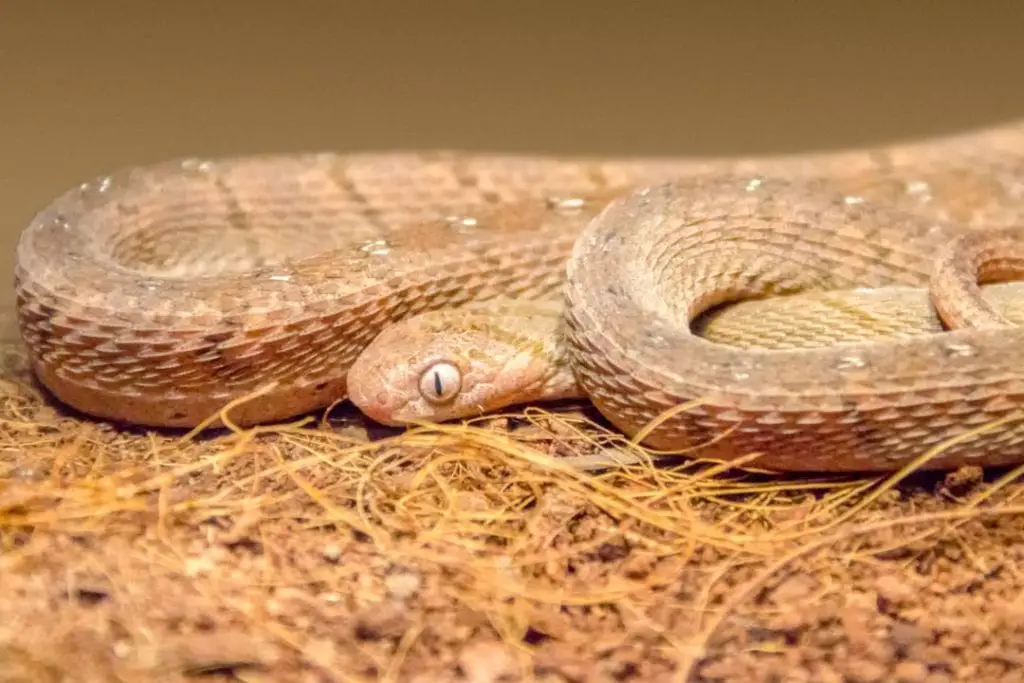
The choice of substrate in the enclosure deserves special consideration as it can impact your snake’s husbandry needs.
The substrate is important because it absorbs fluid, helps maintain the humidity, provides a comfortable surface for the snake, and offers a place to hide.
Since each snake species has its own husbandry needs, the role of substrates will vary with the species. Maintaining high humidity levels is not a concern when keeping an African egg-eating snake.
Also, this species does not burrow. So the role of substrate when keeping African egg-eating snakes is mainly to absorb liquids and provide a comfortable surface for them.
One of the most widely used substrates for snakes is aspen shavings. Aspen shavings do not contain dust and odors that can irritate your snake.
Other kinds of shavings, such as pine and cedar, can irritate reptiles’ respiratory tract. Further, using sand as a substrate can create intestinal blockage when ingested by the snake during feeding.
Other forms of substrate that are good to use are coconut husks and cypress mulch.
Good choices for substrate include Zoo Med Aspen Snake Bedding, Zilla Jungle Mix, and Reptile Prime Coconut Fiber Reptile Substrate.
You will only need about an inch depth when using substrate since African egg-eating snakes are not a burrowing species.
If you are not looking for a natural look, you could also use paper towels or newspapers. Spot clean the enclosure daily and completely replace the substrate monthly.
Heating
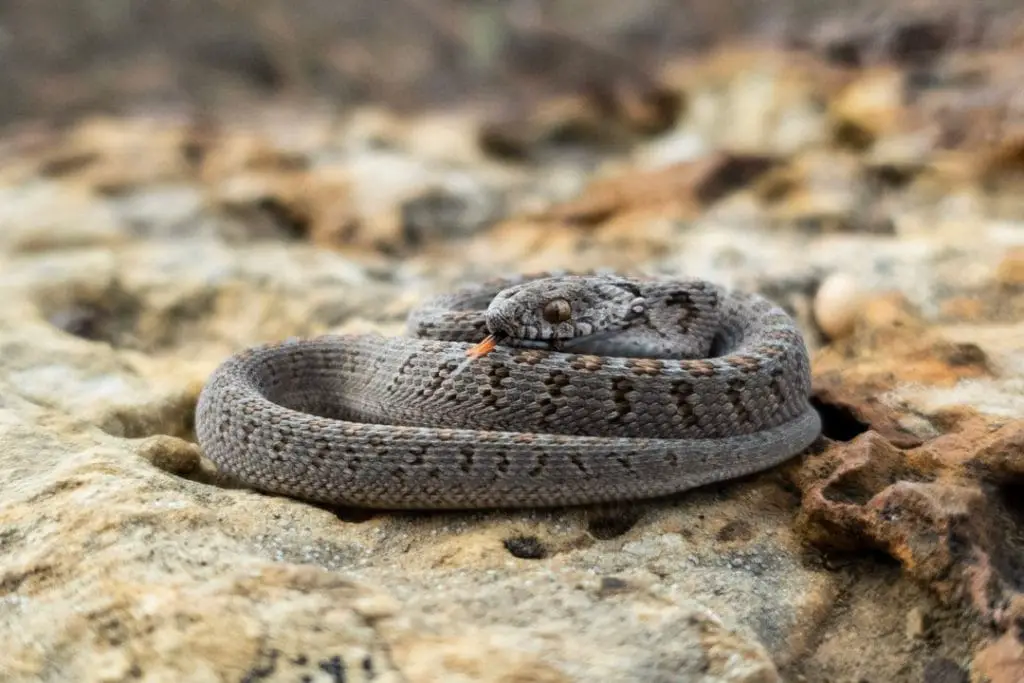
One characteristic of reptiles is that they are exothermic, also known as “cold-blooded.” This means that they cannot regulate their temperature internally as we do.
Instead, they need to seek the appropriate environmental conditions to warm up or cool down.
For this reason, it is important to provide your snake with a range of temperatures that it can choose from.
When you set up the enclosure so that there is a temperature variation, you have created a thermal gradient. A thermal gradient simply means that one part of the enclosure is warmer than the other.
Enclosure Temperature Gradient for African Egg-Eating Snakes
The average ambient temperature of the enclosure should be approximately 70 degrees Fahrenheit, while the warmest part of the enclosure should be around 90 degrees Fahrenheit.
The enclosure temperature should never go lower than 60 degrees Fahrenheit.
If needed, Zoo Med and other brands make under-tank heaters.
The use of heating rocks is not recommended as they have burned reptiles.
Choose a heating method that does not allow your snake to contact it directly. Lastly, purchase two thermometers to check the temperature readings of the warmest and coolest parts of the enclosure.
Light
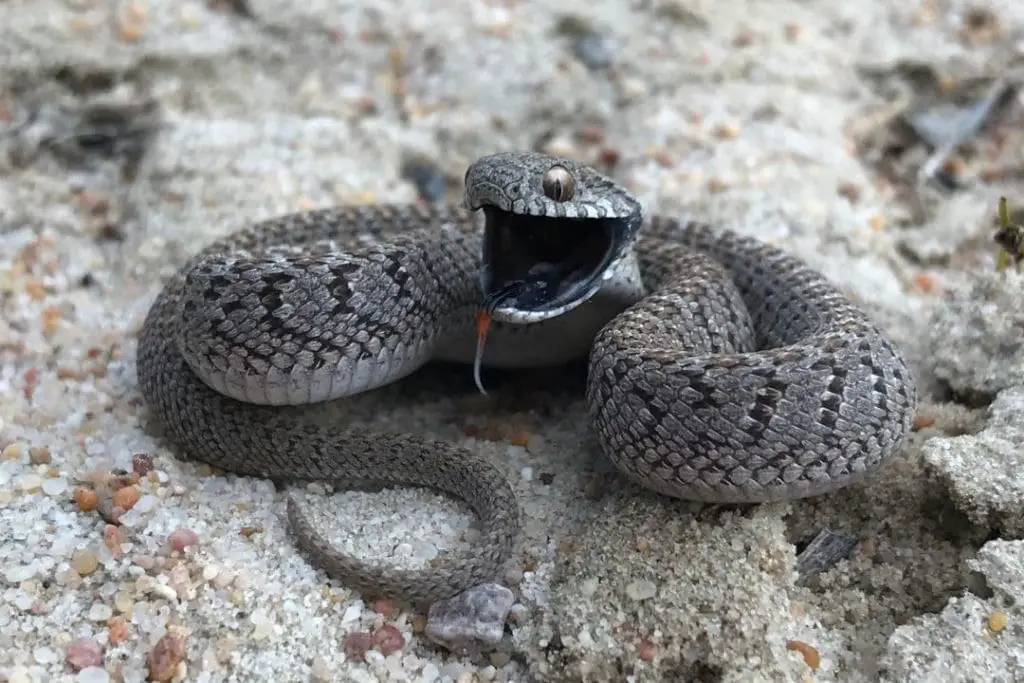
Being nocturnal, African egg-eating snakes do not require UVB lighting. However, some reptile keepers provide UVB lighting because they believe it still provides health benefits, such as promoting the synthesis of calcium.
For this reason, it is a matter of personal choice.
Providing a heat light to ensure that the proper temperature of the upper part of the thermal gradient is reached is another story. Heat bulbs, as can thermostat to maintain the proper temperature.
When it comes to lighting, it is important to provide your snake with a regular day and night schedule. You can accomplish this by purchasing a timer to schedule when the enclosure’s lights turn on and off.
Shelter & Decorations
Because African egg-eating snakes are so widely distributed, it is difficult to pick a biotype to copy. For this reason, providing a basic natural setup is good enough to meet your snake’s needs.
Objects for Climbing
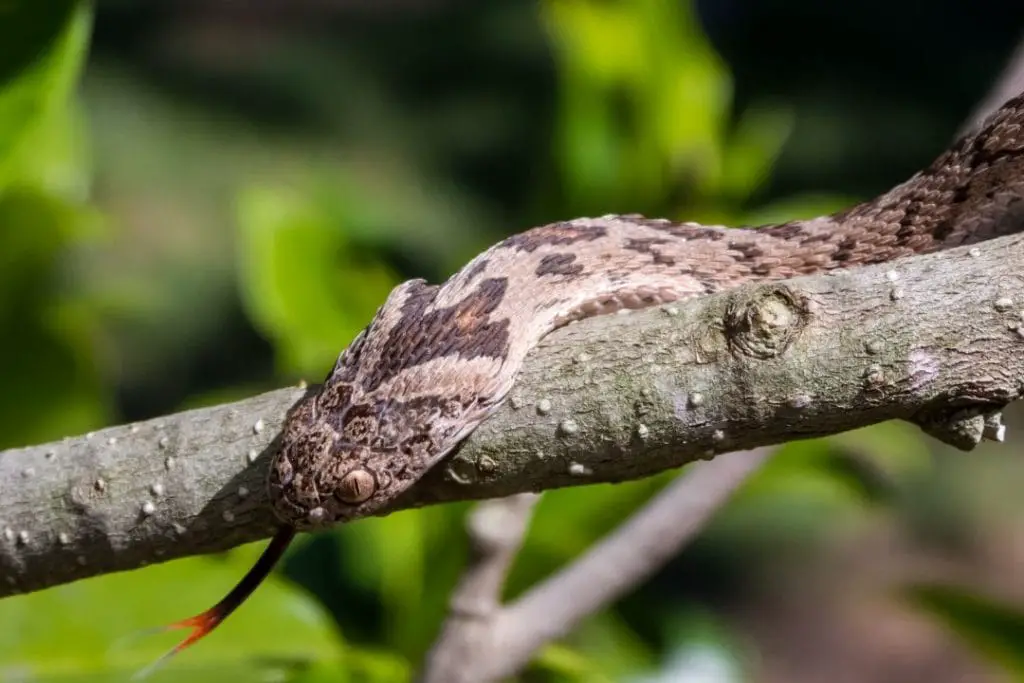
As stated earlier, African egg-eating snakes are excellent climbers, so provide your pet with objects to climb on. Add to the enclosure branches, vines, plastic plants or sticks for it to climb on and as a form of enrichment.
It is important to note that you should not use branches or other sturdy plants materials that you find outdoors. Branches brought in from the outdoors can be infested with parasites. Instead, get your branches from a pet supply dealer.
As an alternative, you can also use artificial plants, which can be obtained from a pet supply dealer or crafts store. As a form of enrichment, rearrange the climbing objects every so often to provide novelty for your snake.
Hide Boxes
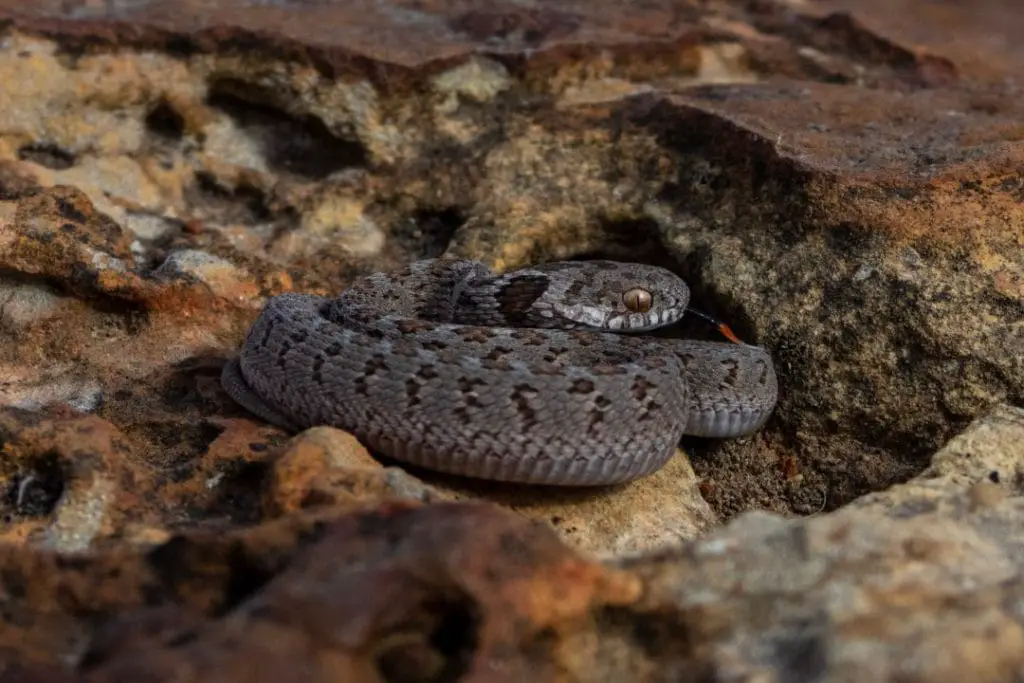
Hide boxes are an important feature for any snake enclosure as they provide a sense of security for the snake, help it in thermoregulation, and assist in shedding.
All snakes need a place to feel secure in as snakes do not spend much time in the open.
In an earlier section, thermal gradients were discussed. The enclosure should be set up so that part of it is kept above the ambient temperature while other parts should be kept at or below the ambient temperature.
Where to place Hides
The enclosure should have a minimum of two hides, with one being placed on the hot end of the enclosure and the other on the cooler part. In doing so, your snake can feel secure no matter what part of the thermal gradient it chooses.
Hides are also valuable for when it is time for your snake to shed its skin. Prior to shedding, snakes feel extra vulnerable as their sense of vision is reduced.
This is because the eye caps ( a thin layer of skin around the eyes) become clouded.
Hides provide a secure place for snakes when they are getting ready to shed. You can further assist your snake by placing damp moss in the hide. The added humidity will be welcomed by your snake!
When selecting a hide for your snake, you should select one which is just big enough for your snake to curl up in. It is important for snakes to feel the sides of the hide when they are in the curled-up position, as this is what gives them a sense of security.
Water
For African egg-eating snakes, a small water dish will meet your pet’s needs. This snake species is not known for soaking in water, unless perhaps during shedding time.
The water dish should be heavy enough to prevent it from tipping it over.
Also, having a water dish will help in keeping up the humidity, if necessary. It is important to clean the dish whenever it appears dirty to avoid the growth of harmful bacteria.
Humidity
Recommended Humidity Levels for Dasypeltis Snakes
The humidity level for African egg-eating snakes should be kept between 40 to 60 percent. As this species come from arid parts of the world, their humidity requirements are not difficult to meet.
If needed, you can raise the humidity level of the enclosure by misting it daily. Also, the use of substrate in the enclosure will also help maintain moisture.
Having live plants in the enclosure can also help maintain the humidity level. It is recommended that you purchase a hygrometer so that you can measure the humidity level.
Go for only quality hygrometers as the cheap ones tend to give inaccurate readings.
Enclosure Maintenance
Maintenance of the enclosure for this species is simple if you keep up with it daily. The enclosure should be spot cleaned daily to remove feces, eggshells, or any other waste products that you can find.
Replace the substrate monthly to avoid the growth of bacteria and fungi.
As for the water dish, change the water daily and clean the water dish weekly. Lastly, check the temperature and humidity levels daily.
Feeding
When it comes to keeping African egg-eating snakes, it is their feeding requirements that are the most challenging part of their husbandry.
The diet of the African egg-eating snake consists exclusively of eggs! To meet the challenges of feeding this species, it is helpful to understand its feeding habits in the wild.
African egg-eating snakes are masters in finding and consuming their egg-based meals. Being agile climbers, these snakes climb trees in search of bird nests.
Their extraordinary sense of smell guides them. Not only can the African egg-eating snake smell eggs from a distance, but they can also determine the stage of incubation that the eggs are at.
These snakes will not eat older eggs or ones with a developing embryo. These snakes only seek out freshly laid unfertilized eggs as their digestive system is designed only to handle undeveloped eggs.
When the snake finds an egg, it swallows it whole. They are able to swallow eggs that are much larger than the size of their heads.
While most snakes have the ability to swallow oversized prey, this is even more so in the rhombic egg eater.
Because the diet of these snakes is restricted to eggs, they lack teeth. Instead, they adapted to have a bony protrusion on the inside of their spine.
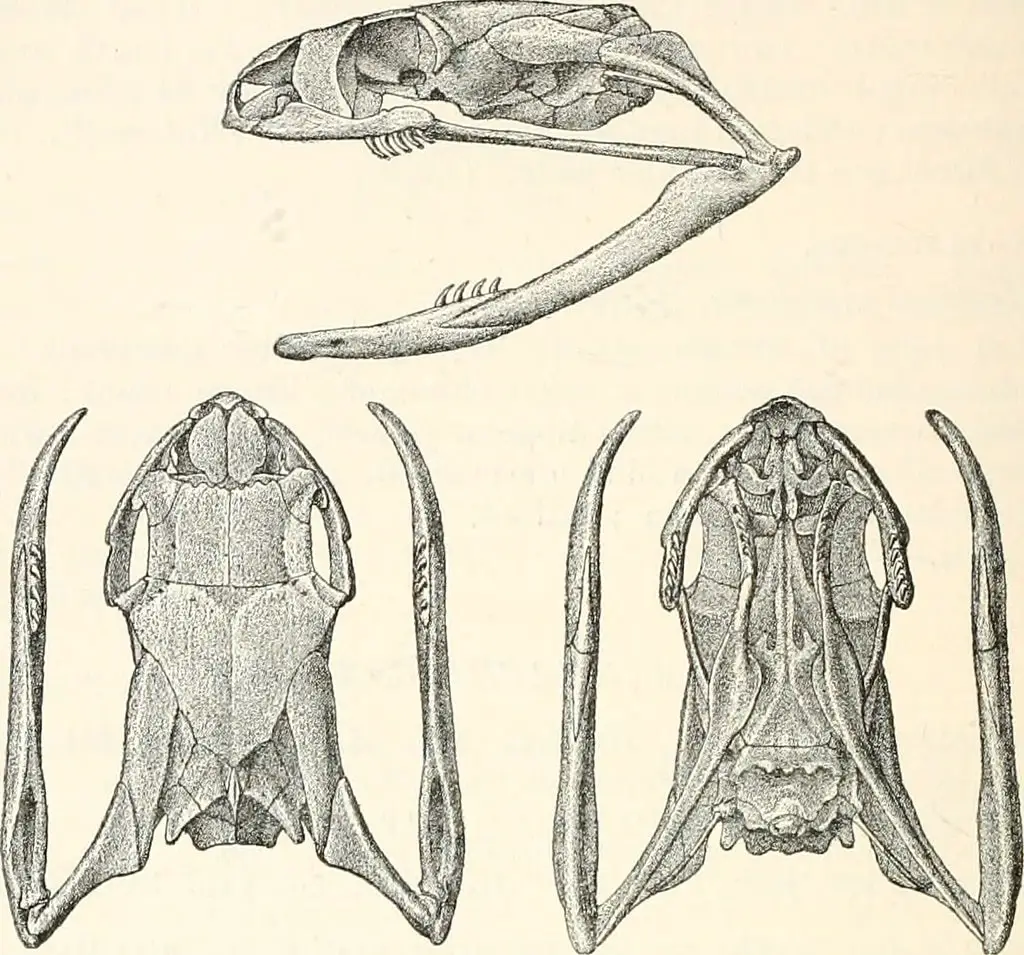
As the snake swallows the egg, it will contort its body, causing this protrusion to rupture the eggshell. They will not swallow eggshells, the snake swallows the liquid part of the egg and regurgitates the egg shell.
Type and Size of Eggs
You may think that a snake that only eats eggs would be easy to feed. The problem is that they cannot be fed chicken eggs as they are too large for them to handle.
In captivity, the eggs most frequently fed to this species are quail, canary, and finch eggs. To keep this species, you will need to find a steady source of fresh eggs from these smaller bird species.
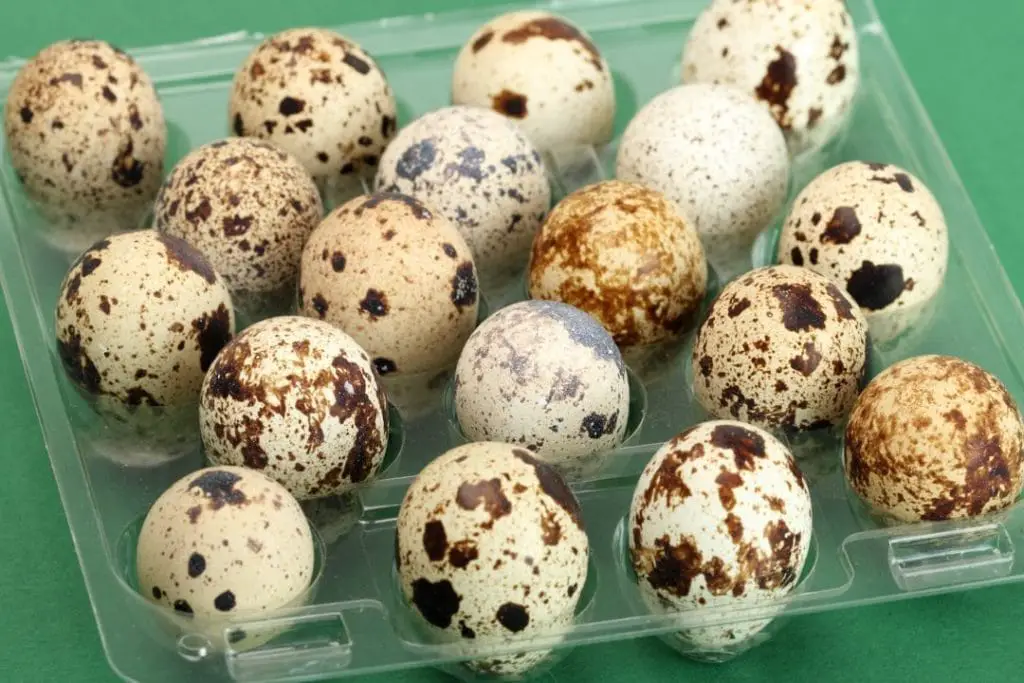
Adult African egg-eating snakes do well on Coturnix quail eggs, which can be found in some supermarkets.
Smaller egg eater snakes specimens can be fed button quail or finch eggs.
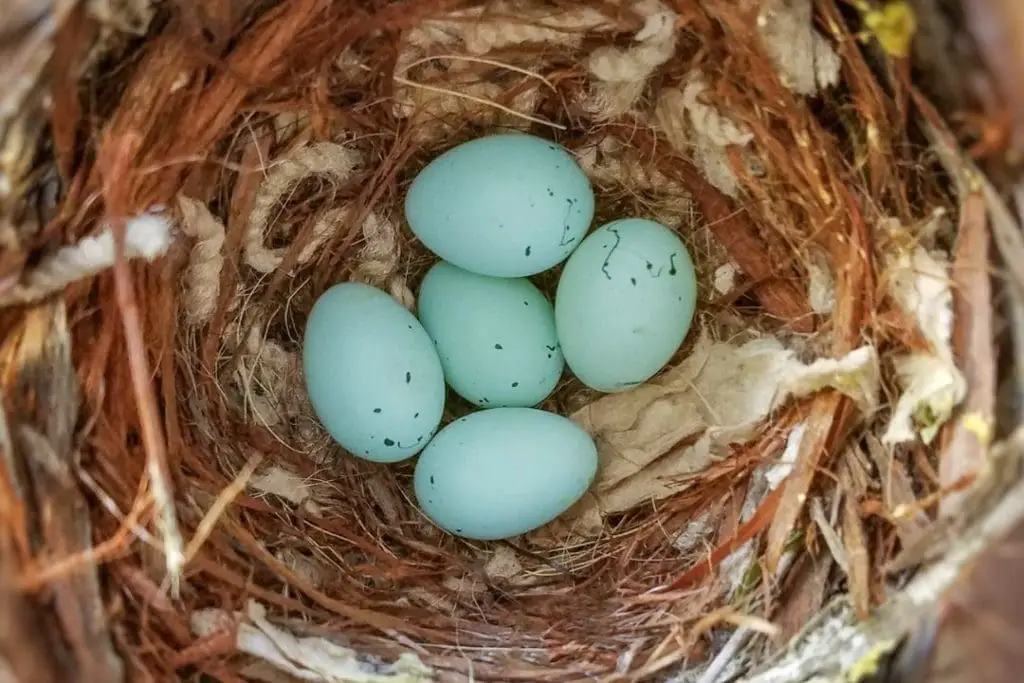
Additionally, these eggs need to be unfertilized.
How to feed eggs
To keep the eggs fresh, you can refrigerate them; however, you will need to warm up the eggs to room temperature. These snakes show no interest in cold eggs.
Reptile keepers have different methods for feeding African egg-eating snakes. Some will place the eggs in a dish while others feed their snakes in a separate container.
Others make artificial bird nests, secure them to branches, and place the eggs there.
This latter method mimics the snake’s natural feeding behavior where the snake will try to locate bird nests. However, all of these methods accomplish one common objective.
They avoid having the snake ingest substrate while swallowing its food. Ingested substrate can cause intestinal blockage.
How often do they eat?
Wild African egg-eating snakes frequently go for long periods of time without eating fresh eggs. This makes sense when you consider that birds are seasonal when it comes to laying eggs. It is common for this species to eat only once a month.
While young, these snakes should be fed once a week. Juveniles can be fed approximately every ten days, while adults can be fed monthly.
For these reasons, it is best to get an adult snake as they can eat larger eggs and eat less often.
Shedding
As with other snake species, the African egg-eating snake will shed its skin to accommodate its growth. Adult snakes may shed several times a year, while younger snakes will shed more often due to their greater growth rate.
Trouble with shedding can appear in snakes as the inability to shed or shedding in patches instead of the whole skin.
Should this occur, try increasing the humidity level, provide damp moss in the humid hide box, or let your snake bathe in warm water.
If none of these methods work, have your snake seen by a veterinarian who is familiar with treating reptiles.
Hibernation
Ectothermic animals, meaning “cold-blooded,” do not hibernate. Rather, they brumate. The difference between brumation and hibernation is that animals who brumate remain awake, but their metabolism slows down.
Hibernation, which warm-blooded animals use, involves the animal going into a deep sleep. Also, their metabolism is reduced to a greater degree than during brumation.
If you live in a cooler part of the country, your Dasypeltis may go into brumation.
Continue to offer food, but do not be concerned if they do not eat. Their appetite should pick up when the weather becomes warmer.
Handling
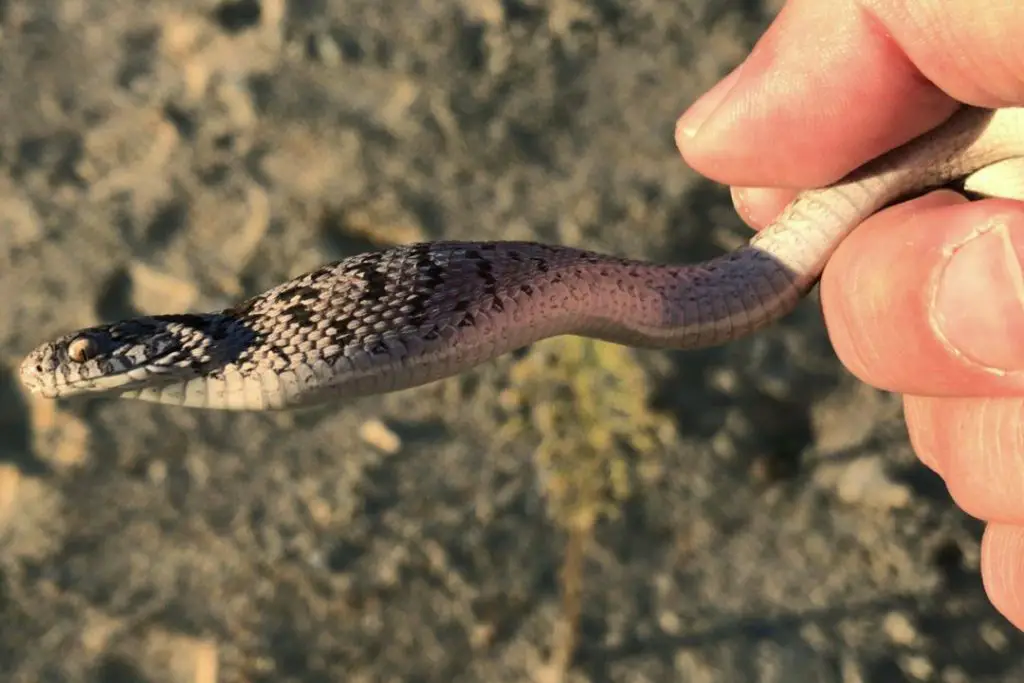
If you purchase any member of the Dasypeltis species, you can be pretty sure that it was wild-caught as this species is not captive-bred.
Combine this fact with a nervous disposition, and it will take patience for this snake to calm down.
When this snake gains trust in you, it will reveal its even-tempered and docile personality. Gaining your snake’s trust begins with giving it time to get adjusted to its new home.
When your snake has become used to its new home, you can start handling it. Regular handling will help your snake get over its nervous behavior.
When handling your African egg-eating snake, it is important to support its body and make it comfortable. Never grab your snake.
Instead, guide its movements when handling it as a way to keep control of it. The handling sessions should be only a few minutes in the beginning. You can extend the sessions as your snake becomes more used to you.
One trick you can do for a nervous snake is to hold it above your head. Doing so will make the snake feel safer. The African egg-eating snake rarely bites.
Further, it lacks teeth. When it feels threatened, it will rub its scales together to create a hissing sound. The handling session should end if it demonstrates this behavior.
Keep in mind that you should not hold your snake after it has eaten. Allow it two hours to digest its food before handling it.
Breeding
There is no commercial captive breeding of this species, and they rarely breed in captivity. An African egg-eating snake that is sold will be wild-caught.
Common Health Issues
Why is my egg-eating snake not eating?
Getting new African egg-eating snakes to eat is a common problem for reptile keepers. It is not uncommon for this species to eat only once a month.
As long as the snake appears healthy, do not worry about it. Keep offering food. Make sure the egg is small enough for your snake, and remember that chicken eggs are too large for your snake.
Also, the egg needs to be warm. If you refrigerate your eggs, let them warm up to room temperature.
Another technique is to get some sandpaper and scrape away the shell from one end of the egg until you reach the membrane. This may pique your snake’s interest.
You should avoid force-feeding your snake unless you have experience doing so. You can cause injury to your snake if you do not do it right. If needed, consult a veterinarian who is experienced with reptiles.
Why is my egg-eating snake regurgitating?
Regurgitation is a normal part of the feeding process of egg-eating snakes. The Dasypeltis species has a bony protrusion below its spine.
The snake uses this protrusion to crack the egg open. The snake ingests the liquid part of the egg and regurgitates the shell. It is important for the health of your snake to remove the shells and spot the clean enclosure as needed.
Respiratory infection
Respiratory infections are caused by incorrect husbandry procedures. More specifically, this disease Is caused by improper humidity or temperature levels.
The cause of the infection can be viral, fungal, or parasites. The symptoms of respiratory infections include:
- Breathing difficulties.
- The mouth is kept open.
- Making sounds while breathing.
- Nasal discharge and discharge from the mouth.
- Sluggishness
- Poor appetite
- Loss of weight
It is important that you bring your snake to a veterinarian who has knowledge of reptiles.
Frequently Asked Questions
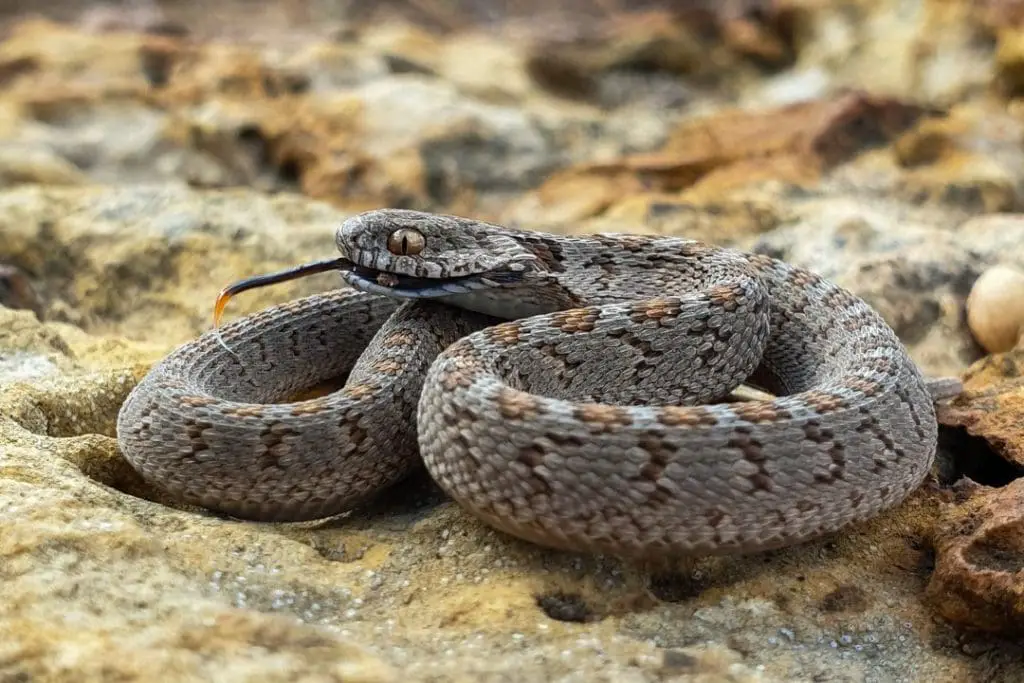
Conclusion
We hope you enjoyed this care guide and welcome your questions or comments. I hope that in the future breeders will succeed in reproducing this interesting pet in captivity.
Sources
Gartner, G.E.A. and Greene, H.W., 2008. Adaptation in the African egg‐eating snake: a comparative approach to a classic study in evolutionary functional morphology. Journal of Zoology, 275(4), pp.368-374.
Lopez, T.J., Maxson, L.R. and Dowling, H.G., 1993. Phylogenetic relationships of the African egg-eating snake Dasypeltis scabra. Amphibia-reptilia, 14(3), pp.223-236.
Greene, S., McConnachie, S., Secor, S. and Perrin, M., 2013. The effects of body temperature and mass on the postprandial metabolic responses of the African egg-eating snakes Dasypeltis scabra and Dasypeltis inornata. Comparative Biochemistry and Physiology Part A: Molecular & Integrative Physiology, 165(2), pp.97-105.
